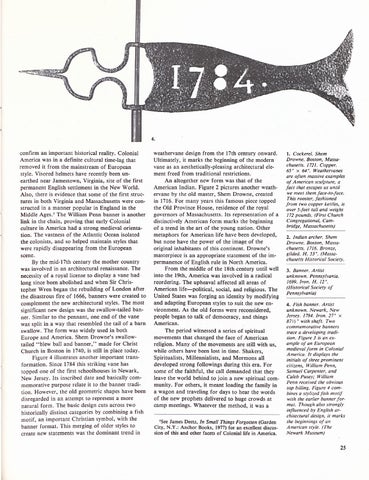confirm an important historical reality. Colonial America was in a definite cultural time-lag that removed it from the mainstream of European style. Visored helmets have recently been unearthed near Jamestown, Virginia, site of the first permanent English settlement in the New World. Also, there is evidence that some of the first structures in both Virginia and Massachusetts were constructed in a manner popular in England in the Middle Ages.' The William Penn banner is another link in the chain, proving that early Colonial culture in America had a strong medieval orientation. The vastness of the Atlantic Ocean isolated the colonists, and so helped maintain styles that were rapidly disappearing from the European scene. By the mid-17th century the mother country was involved in an architectural renaissance. The necessity of a royal license to display a vane had long since been abolished and when Sir Christopher Wren began the rebuilding of London after the disastrous fire of 1666, banners were created to complement the new architectural styles. The most significant new design was the swallow-tailed banner. Similar to the pennant, one end of the vane was split in a way that resembled the tail of a barn swallow. The form was widely used in both Europe and America. Shem Drowne's swallowtailed "blew ball and banner," made for Christ Church in Boston in 1740, is still in place today. Figure 4 illustrates another important transformation. Since 1784 this striking vane has topped one of the first schoolhouses in Newark, New Jersey. Its inscribed date and basically commemorative purpose relate it to the banner tradition. However, the old geometric shapes have been disregarded in an attempt to represent a more natural form. The basic design cuts across two historically distinct categories by combining a fish motif, an important Christian symbol, with the banner format. This merging of older styles to create new statements was the dominant trend in
weathervane design from the 17th century onward. Ultimately, it marks the beginning of the modern vane as an aesthetically-pleasing architectural element freed from traditional restrictions. An altogether new form was that of the American Indian. Figure 2 pictures another weathervane by the old master, Shem Drowne, created in 1716. For many years this famous piece topped the Old Province House, residence of the royal governors of Massachusetts. Its representation of a distinctively American form marks the beginning of a trend in the art of the young uation. Other metaphors for American life have been developed, but none have the power of the image of the original inhabitants of this continent. Drowne's masterpiece is an appropriate statement of the impermanence of English rule in North America. From the middle of the 18th century until well into the 19th, America was involved in a radical reordering. The upheaval affected all areas of American life—political, social, and religious. The United States was forging an identity by modifying and adapting European styles to suit the new environment. As the old forms were reconsidered, people began to talk of democracy, and things American. The period witnessed a series of spiritual movements that changed the face of American religion. Many of the movements are still with us, while others have been lost in time. Shakers, Spiritualists, Millennialists, and Mormons all developed strong followings during this era. For some of the faithful, the call demanded that they leave the world behind to join a new spiritual community. For others, it meant loading the family in a wagon and traveling for days to hear the words of the new prophets delivered to huge crowds at camp meetings. Whatever the method, it was a 'See James Deetz, In Small Things Forgotten (Garden City, N.Y.: Anchor Books, 1977) for an excellent discussion of this and other facets of Colonial life in America.
1. Cockerel. Shem Drowne. Boston, Massachusetts. 1721. Copper. 65" x 64". Weathervanes are often massive examples of American sculpture, a fact that escapes us until we meet them face-to-face. This rooster, fashioned from two copper kettles, is over 5-feet tall and weighs 172 pounds. (First Church Congregational, Cambridge, Massachusetts) 2. Indian archer. Shem Drowne. Boston, Massachusetts. 1716. Bronze, gilded. H. 53". (Massachusetts Historical Society. 3. Banner. Artist unknown. Pennsylvania. 1699. Iron. H. 12". (Historical Society of Pennsylvania) 4. Fish banner. Artist unknown. Newark, New Jersey. 1784. Iron. 27" x 871 / 2" with shaft. Two commemorative banners trace a developing tradition. Figure 3 is an example of an European medievalform in Colonial America. It displays the initials of three prominent citizens, William Penn, Samuel Carpenter, and Caleb Pusey; William Penn received the obvious top billing. Figure 4 combines a stylized fish motif with the earlier banner format. Though also strongly influenced by English architectural design, it marks the beginnings of an American style. (The Newark Museum) 25
